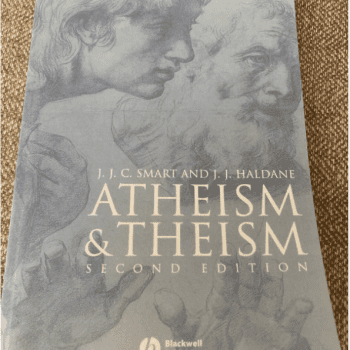My friends Edward Feser and Jay Wesley Richards, both fellow Catholics, are engaged in an online dispute about whether contemporary Intelligent Design theory (ID) runs counter to classical Thomistic understandings of nature and final causality. On this matter, I am with Ed. For I believe that ID, as defended by Michael Behe and William A. Dembski, is a view that in the long run serves to undermine rather than advance the cause of Christian theism. Of course, I see why some of my fellow Christians, both Protestants and Catholics, are so attracted to ID. For it promises to beat the apologists of atheism at their own game with the only tools they believe are epistemically appropriate, the methods of the empirical sciences. But this posture, it seems to me, uncritically accepts this first premise, which is inherently hostile to the sort of metaphysical thinking on which large swaths of the Christian worldview depend. To get an idea of what I mean, what follows is an excerpt from my recent article published in Synthese, “Or We Can Be Philosophers: A Response to Barbara Forrest” (citations omitted):
runs counter to classical Thomistic understandings of nature and final causality. On this matter, I am with Ed. For I believe that ID, as defended by Michael Behe and William A. Dembski, is a view that in the long run serves to undermine rather than advance the cause of Christian theism. Of course, I see why some of my fellow Christians, both Protestants and Catholics, are so attracted to ID. For it promises to beat the apologists of atheism at their own game with the only tools they believe are epistemically appropriate, the methods of the empirical sciences. But this posture, it seems to me, uncritically accepts this first premise, which is inherently hostile to the sort of metaphysical thinking on which large swaths of the Christian worldview depend. To get an idea of what I mean, what follows is an excerpt from my recent article published in Synthese, “Or We Can Be Philosophers: A Response to Barbara Forrest” (citations omitted):
Take, for example, Mark Ryland, a former vice president of the Discovery Institute, and now the director of the Institute for the Study of Nature. He writes in the New Catholic Encyclopedia: “In some respects, standard reductionistic neo-Darwinism and IDT [intelligent design theory] are mirror images of each other, and suffer from some of the same defects”…. What does Ryland mean by this?
According to Dembski, we discover design in nature after we have eliminated chance and law. And we do so by a conceptual device he calls the explanatory filter. If something in nature exhibits a high level of specified complexity for which chance and law cannot account, Dembski concludes that it is highly probable that the gap is the result of an intelligent agent. Design, therefore, is not immanent in nature. It is something that is imposed on nature by someone or something outside it.
This means that for Dembski as well as other ID advocates, nature’s order, including its laws and principles, need not require a mind behind it except for in the few instances where the explanatory filter allows one to detect design. But whatever design we detect, it can always be overturned by future discoveries, and thus conceding yet another slice of nature to naturalism.
So, ironically, as Ryland notes, ID advocates, like Dembksi and Behe, and defenders of naturalism, like Richard Dawkins and Jerry Coyne, wind up agreeing that without “gaps” in nature one is not justified in believing that there is design in nature. The IDer thinks he can fill the gaps with intelligent agents; the atheist sees no reason to abandon fruitful theories because of a few anomalies for which he thinks he can someday account. Ironically, Dembski accepts this narrative, but is confident that the naturalists will not be able to “explain” everything:
The “gaps” in the god-of-the-gaps objection are meant to denote gaps of ignorance about underlying physical mechanisms. But there is no reason to think that all gaps give way to ordinary physical explanations once we know enough about the underlying physical mechanisms. The mechanisms simply do not exist. Some gaps might constitute ontic discontinuities in the chain of physical causes and thus remain forever beyond the capacity of physical mechanisms….
This, however, is not the only option for Christian theists. Followers of St. Thomas Aquinas (Thomists) and many other Christian thinkers do not accept this philosophy of nature…. For the Thomist, design is immanent in the universe, and thus even an evolutionary account of the development of life requires a universe teeming with final causes. What is a final cause? It is a thing’s purpose or end. So, for example, even if one can provide an evolutionary account of the development of the human lungs without any recourse to an intervening intelligence, there remains the fact that the lungs develop for a particular purpose, the exchange of oxygen for the sake of the organism’s survival. This fact, of course, does not contravene the discoveries of modern biology. And neither does it mean that final causes should be inserted into scientific theories. All it means is that the deliverances of the sciences—even if they need no intelligent intervention to be complete—can never be nature’s whole story. For the Thomist, and for many other Christians, law and chance do not eliminate design. “Design” does not replace efficient and material causes in nature when the latter two appear impotent as explanations (i.e., Dembski’s “gaps”). Rather, efficient and material causes require final causes. For example, my belief that the lungs’ purpose is to exchange oxygen is not falsified simply because I can provide an exhaustive scientific account of the natural processes of the evolution and development of the lungs. This is because final causality is not a substitute for a scientific account of nature. For the natural processes—even if they are complete and exhaustive–seem to work for an end, and that end is its final cause. This is why, in his famous Five Ways (or arguments) to show God’s existence, St. Thomas includes as a fifth way an argument from the universe’s design as a whole, appealing to those scientific laws that make motion possible…. For this reason, I write in a recent article [in the University of St. Thomas Journal of Law and Public Policy]: “[Although] I have maintained and continue to maintain that ID may be taught in public schools without violating the Establishment Clause… [,] I sincerely hope that no public school teaches it. For I think that ID advances an inadequate philosophy of nature that suggests a philosophical theology that is inconsistent with classical Christian theism”….












